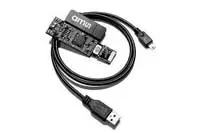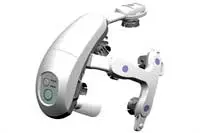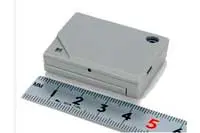Electronics News
Archive : 20 July 2016 год
 Proximity sensing and proximity/ambient light sensing modules – the TMD2620 and the TMD2725 respectively – have been introduced by ams.
Proximity sensing and proximity/ambient light sensing modules – the TMD2620 and the TMD2725 respectively – have been introduced by ams.
They enable Android smartphone manufacturers to reduce the sensor aperture in the display’s cover glass by up to 50%, improving aesthetic appeal, especially in devices with a white or light coloured bezel. The TMD2620 and TMD2725 enable aperture size as small as 1.4 and 2mm respectively.
They also allow the emitter – an infra-red LED – and photodiode to be placed 1mm apart. Lenses on top of the emitter and sensor, along with an optical barrier between them, minimise crosstalk caused by reflections from the surfaces of the cover glass. Offset adjustment registers eliminate the effect of any residual crosstalk from the module’s proximity calculations. Automatic ambient light subtraction enhances the accuracy of the device’s proximity measurements. The ability to measure up to a range of 100mm is comparable to laser-based solutions.
“Until now, inability to overcome the effects of optical crosstalk have prevented Android phone manufacturers from reducing proximity sensing apertures to less than 3mm”, said Herbert Truppe, senior marketing manager at ams. “Now the TMD2620 and TMD2725 overcome those challenges and enable a smaller aperture than has previously been possible.”
Author
Peggy Lee
Source: www.newelectronics.co.uk
 A magnetic memory chip embedded on a flexible plastic material has been developed by an international research team led by associate professor Yang Hyunsoo, pictured, from the National University of Singapore.
A magnetic memory chip embedded on a flexible plastic material has been developed by an international research team led by associate professor Yang Hyunsoo, pictured, from the National University of Singapore.
Flexible magnetic memory devices are a fundamental component required for wearable electronics and biomedical devices but there are still challenges in making high performance memory chips on flexible substrates without sacrifcing performance.
According to the researchers – from Yonsei University, Ghent University and Singapore's Institute of Materials Research and Engineering – the malleable memory chip is a further step towards making flexible, wearable electronics a reality in the near future.
The magnetoresistive random access memory (MRAM) uses a magnesium oxide (MgO)-based magnetic tunnel junction (MTJ) to store data. MRAM outperforms conventional RAM in many aspects, including the ability to retain data after a power supply is cut off, high processing speed, and low power consumption.
The research team first grew the MTJ on a silicon surface, and then etched away the underlying silicon. Using a transfer printing approach, the team implanted the memory on a flexible PTFE surface while controlling the amount of strain.
Prof Yang said: “Our experiments showed that our device’s tunnelling magnetoresistance could reach up to 300% – it’s like a car having extraordinary levels of horsepower. We have also managed to achieve improved abruptness of switching. With all these enhanced features, the flexible magnetic chip is able to transfer data faster. We are the first team to fabricate magnetic memory on a flexible surface, and this significant milestone gives us the impetus to further enhance the performance of flexible memory devices and contribute towards the flexible electronics revolution.”
Prof Yang and his team are planning to apply their technique to other electronic components.
Author
Peggy Lee
Source: www.newelectronics.co.uk
 A team of scientists at the Kavli Institute of Nanoscience at Delft University has built a 1kbyte memory in which each bit is represented by the position of a chlorine atom. The storage density of 500Tbit/sq in is said to be 500 times greater than the best commercial hard disk currently available.
A team of scientists at the Kavli Institute of Nanoscience at Delft University has built a 1kbyte memory in which each bit is represented by the position of a chlorine atom. The storage density of 500Tbit/sq in is said to be 500 times greater than the best commercial hard disk currently available.
The device was created using a scanning tunnelling microscope, not only allowing the team to see the atoms, but also to move them. “You could compare it to a sliding puzzle,” said lead scientist Sander Otte. “Every bit consists of two positions on a surface of copper atoms and one chlorine atom that we can slide back and forth between these two positions. If the chlorine atom is in the top position, there is a hole beneath it – we call this a 1. If the hole is in the top position, then the bit is a 0.”
Because the chlorine atoms are surrounded by other chlorine atoms, except near the holes, they keep each other in place and the approach is said to be more stable and more suitable for data storage.
The researchers organised the memory in 8byte blocks. Each block has a marker made of the same type of ‘holes’ as the raster of chlorine atoms. Said to be inspired by QR codes, markers carry information about the precise location of the block on the copper layer. The code will also indicate if a block is damaged, for instance due to some local contaminant or an error in the surface. This is said to allow the memory to be scaled to big sizes, even if the copper surface is not entirely perfect.
Otte noted: “In its current form, the memory can operate only in very clean vacuum conditions and at liquid nitrogen temperature (77 K), so the storage of data on an atomic scale is still some way off. But we have certainly come a big step closer.”
Author
Graham Pitcher
Source: www.newelectronics.co.uk
 A wireless electroencephalogram (EEG) device to monitor emergency room and intensive care unit patients has been developed by imec and Holst Centre in collaboration with Nihon Kohden.
A wireless electroencephalogram (EEG) device to monitor emergency room and intensive care unit patients has been developed by imec and Holst Centre in collaboration with Nihon Kohden.
The prototype was used by Nihon Kohden to develop a wireless EEG monitoring solution, which was launched earlier this month in Japan. The prototype was based on imec’s proprietary EEG solution and featured 8 channels of EEG with disposable electrodes that optimise speed and ease of setup. Additionally, the prototype headset had to meet the performance requirements of the Japanese standard for clinical EEG monitoring.
“In this collaboration with Nihon Kohden, we leveraged our proprietary EEG monitoring headset and our extensive expertise in EEG sensing with active amplifier, and ergonomic design to realize a customised prototype EEG headset that met the requirements of Nihon Kohden’s specific solution,” stated Chris Van Hoof, program director wearables at imec. “We are excited with this achievement which demonstrates the profound value of our research and development in supporting our partners with their product innovation. This is an example of how imec aims to advance healthcare with more sustainable, patient-centric solutions.”
In 2014, imec and Holst Centre unveiled a headset they claimed paved the way for wireless EEG monitoring.
Author
Peggy Lee
Source: www.newelectronics.co.uk
Acal BFi has announced a strategic partnership with Fujitsu under which it will distribute the latter’s range of wireless modules and beacons, including the complete family of Bluetooth low energy modules across Europe.
Lee Austin, Acal BFi’s business development director, said: “We are delighted to announce our distribution agreement with Fujitsu. The addition of Fujitsu’s Bluetooth low energy technology to our wireless product portfolio represents a great opportunity for Acal BFi in the fast moving Bluetooth low energy market.”
 The wireless module product range comprises WLAN, Bluetooth and WLAN Bluetooth combination modules, with Apple iOS chipset support. Beacons are Bluetooth powered location devices that enable proactive communication and are used in applications such as in shop promotion, museum, festivals and exhibitions.
The wireless module product range comprises WLAN, Bluetooth and WLAN Bluetooth combination modules, with Apple iOS chipset support. Beacons are Bluetooth powered location devices that enable proactive communication and are used in applications such as in shop promotion, museum, festivals and exhibitions.
Author
Graham Pitcher
Source: www.newelectronics.co.uk

